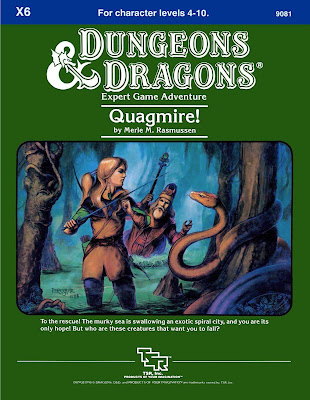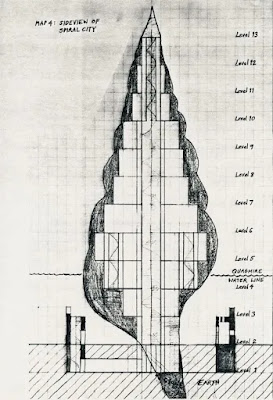X6 "Quagmire!" (1984) by Merle M. Rasmussen is a D&D wilderness adventure for character levels 4-10, detailing the Wild Lands to the west of the Sea of Dread.
Module X6 "Quagmire!" (1984) by Merle M. Rasmussen. Cover illustration by Steve Peregrine.
The Adventure:
I posted a review of this module on Dragonsfoot, back in 2010.
While a fascinating map to explore, the main flaw in the adventure is one of size and scope. X1 "The Isle of Dread" works better as a hexcrawl, since the island is manageable in size (with 6 mile hexes) as opposed to "The Wild Lands" in "Quagmire!" (with 24 mile hexes).
The encounter density becomes too sparse to maintain dramatic tension. Weeks and weeks go by, as opposed to the day by day exploration involved in module X1, the party moving 1-2 instead of 4-8 hexes per day, which negatively impacts pacing.
For this reason, the rescue of the citizens of Quagmire really works best as a side quest for a larger campaign set in the Wild Lands. The PCs should find Molariah's message* in a bottle while already exploring Serpent Peninsula.
*complete with labels on the roughly sketched map, as in Rasmussen's original version, omitted in the published version
The Calendar:
A table indicating the percentage chance of gales and hurricanes uses the months of our own calendar. This did not seem out of place, back in the day, since Tolkien did the same.
Design Origins:
The origins of module X6 "Quagmire!" are described in detail in "Quagmire! The Making of a 1980's D&D Module" (December 29, 2014) by Jon Peterson.
Side view of spiral city. Illustration by Merle M. Rasmussen.
Rasmussen originally submitted two one-page briefs as ideas for D&D Expert modules. The first was titled "Frozen Burial Mounds of the Southmarch" and the second "Quagmire of the Swamp King":
Characters must cross a bog having a surface that yields with each step* past slimy creatures half burrowed in the muck to reach the highground of the Swamp King. He is searching for only the best adventurers to chart his kingdom so safe navigation by ship can occur.
Merle M. Rasmussen, (July 23, 1982)
The initial brief for "Quagmire" was approved and expanded upon:
D&D characters must cross a fog-covered bog past slimy creatures half burrowed in the muck to reach the last highground of the benevolent but dying Swamp King. His plague-ravaged sinking kingdom will soon be gone forever and his surviving followers will perish. Characters must rescue the kingdom's people from their overcrowded rock by finding a safe land or sea route to civilization. Monsters and natural hazards abound threatening to destroy the characters and the kind survivors of the swamp. The swamp king offers only precious herbs and stones in payment for his people's safe passage to new higher ground. When the moon rises again the rock of the Swamp King will sink into oblivion.
Merle M. Rasmussen, (April 22, 1983)
Compare to the final plot outline, with its intriguing mention of ancient roads connecting the various cities (a detail omitted in the published module):
A party of 4th to 10th level adventurers receive an urgent plea for help from Quagmire, an ancient trading port, now sinking into the sea. The party starts out from Slagovich, Specularum, or the Isle of Dread to reach the exotic locale. Along the way, the party will have many encounters, some relating to the mission, and others that simply add excitement to the adventure.
When the party reaches Quagmire they find the city under siege by creatures from the surrounding swamp. Once inside the spiraling city, the party is told that the city's survivors want to be escorted to the legendary city of Thanopolis. Thanopolis supposedly lies on the southwest side of the island of Thanegia. An ancient overgrown road is rumored to run from Quagmire to Thanegia but no one has dared to travel the road in decades.
Thanopolis exists but is infected with swamp and jungle denizens. Within the legendary city, a duplicate of Quagmire, is a map to a third sister city. Another ancient road leads into the sea. Adventurers can try to find the third city if they choose but it sank centuries ago and is now a city for mermen.
Merle M. Rasmussen, (January 4, 1984)
Serpent Peninsula:
The general weather patterns of this part of the world move from east to west. Tbe world’s equator lies just south of Thanegia Island. The climate of this area is similar to that of Florida or Cuba.
Map of Serpent Peninsula from X6 "Quagmire!" indicating a suitable location for I1 "Dwellers of the Forbidden City" (adapted from this map, by Thorfinn Tait)
I've shared my ideas for a X6/I1 Quagmire/Dwellers of the Forbidden City mash-up, including BECMI stats for bullywugs, mongrelmen, tasloi, and yuan ti.
*see also "Jungle Fever" in The Dragon #31 (November, 1979) and "The Voyage of the Princess Ark (Part 17): The Serpent Peninsula revisited" by Bruce Heard, in Dragon #170 (June, 1991)
Shallow Sea:
Legends speak of the Yavdlom, an early race of man that lived here in harmony with the island's natural beauty. At that time, several different forms of life were said to have filled the island. The legends also say, however, that some unknown force eventually decimated the island's life forms, and the Yavdlom apparently moved on to other lands. The unknown force was actually the slow sinking of the land that now makes up the floor of the Shallow Sea.
Quagmire (1984)
*see The Science Behind Florida’s Sinkhole Epidemic
New Monsters:
Fish, Giant (Piranha, Catfish);* Grab Grass;** Killer Trees;** Piranha Bird;*** Pocket Dragon;**** Spider, Giant Hunting****
**appeared in X2 "Castle Amber"
***appeared in B5 "Horror on the Hill"
****appeared in M2 "Maze of the Riddling Minotaur"
Champions of Mystara:
Champions of Mystara, Explorer's Manual (1993) by Ann Dupuis and Bruce Heard. Cover illustration by Fred Fields, from Dragon #142 (February, 1989)
If you wish to play the Quagmire! module in its entirety, you should set the adventure in the year 425 BC, while the People of Yav were exiled to the Immortals' Arm. This works well with a one-shot mini-campaign (with characters you won't be using in your normal campaign) or as a time-traveling side trek for the normal group of player characters.
Champions of Mystara, Explorer's Manual (1993)














No comments:
Post a Comment